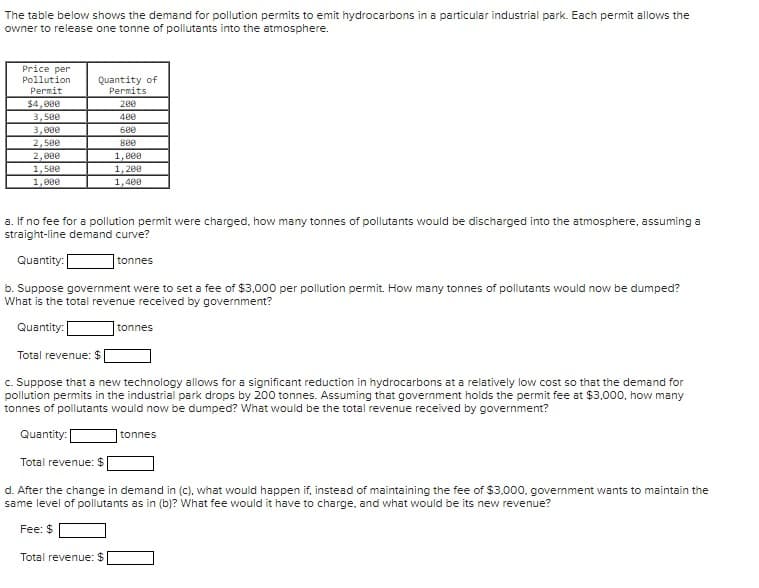straight-line demand curve? Quantity: tonnes b. Suppose government were to set a fee of $3.000 per pollution permit. How many tonnes of pollutants would now be dumped? What is the total revenue received by government? Quantity [ tonnes Total revenue: $[ c. Suppose that a new technology allows for a significant reduction in hydrocarbons at a relatively low cost so that the demand for pollution permits in the industrial park drops by 200 tonnes. Assuming that government holds the permit fee at $3,000, how many tonnes of pollutants would now be dumped? What would be the total revenue received by government? Quantity: [ ]tonnes Total revenue: $
straight-line demand curve? Quantity: tonnes b. Suppose government were to set a fee of $3.000 per pollution permit. How many tonnes of pollutants would now be dumped? What is the total revenue received by government? Quantity [ tonnes Total revenue: $[ c. Suppose that a new technology allows for a significant reduction in hydrocarbons at a relatively low cost so that the demand for pollution permits in the industrial park drops by 200 tonnes. Assuming that government holds the permit fee at $3,000, how many tonnes of pollutants would now be dumped? What would be the total revenue received by government? Quantity: [ ]tonnes Total revenue: $
Chapter44: Human Effects On The Biosphere
Section: Chapter Questions
Problem 9SA
Related questions
Question

Transcribed Image Text:The table below shows the demand for pollution permits to emit hydrocarbons in a particular industrial park. Each permit allows the
owner to release one tonne of pollutants into the atmosphere.
Price per
Pollution
Permit
$4,000
3,500
3,000
Quantity of
Permits
200
400
600
2,500
2,000
1,500
8ee
1,800
1, 200
1,400
1,000
a. If no fee for a pollution permit were charged, how many tonnes of pollutants would be discharged into the atmosphere, assuming a
straight-line demand curve?
Quantity:
tonnes
b. Suppose government were to set a fee of $3,000 per pollution permit. How many tonnes of pollutants would now be dumped?
What is the total revenue received by government?
Quantity:
tonnes
Total revenue: $
c. Suppose that a new technology allows for a significant reduction in hydrocarbons at a relatively low cost so that the demand for
pollution permits in the industrial park drops by 200 tonnes. Assuming that government holds the permit fee at $3,000, how many
tonnes of pollutants would now be dumped? What would be the total revenue received by government?
Quantity:
tonnes
Total revenue: $
d. After the change in demand in (c), what would happen if, instead of maintaining the fee of $3.000. government wants to maintain the
same level of pollutants as in (b)? What fee would it have to charge, and what would be its new revenue?
Fee: $
Total revenue: $
Expert Solution
This question has been solved!
Explore an expertly crafted, step-by-step solution for a thorough understanding of key concepts.
Step by step
Solved in 2 steps

Knowledge Booster
Learn more about
Need a deep-dive on the concept behind this application? Look no further. Learn more about this topic, biology and related others by exploring similar questions and additional content below.Recommended textbooks for you


Human Biology (MindTap Course List)
Biology
ISBN:
9781305112100
Author:
Cecie Starr, Beverly McMillan
Publisher:
Cengage Learning



Human Biology (MindTap Course List)
Biology
ISBN:
9781305112100
Author:
Cecie Starr, Beverly McMillan
Publisher:
Cengage Learning
